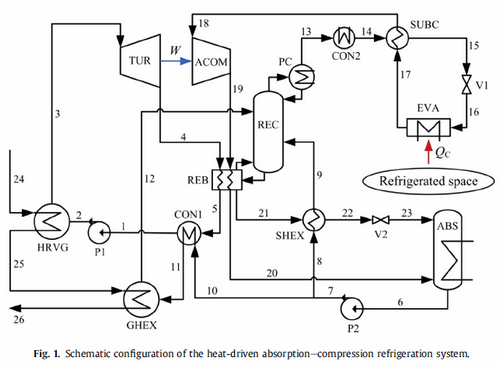An ammonia-water absorption refrigeration system is a promising way to make use of waste heat to generate cooling energy for freezing applications. When the refrigeration temperature is below -30℃, the conventional absorption system cannot be adopted because its performance decreases dramatically. In this work, a totally heat-driven absorption-compression refrigeration system is proposed to produce cooling energy at temperatures of -40℃ to -55℃. The proposed system comprises a heat-driven power generation subsystem using an ammonia-water mixture as the working fluid and an absorption-compression refrigeration subsystem. Simulation results showed that the coefficient of performance and the cooling capacity per unit mass of flue gas reach 0.357 and 84.18 kJ kg_1, respectively. The results of a process energy analysis showed that the cycle coupling configuration of the proposed system
enhances its energy cascade utilization. Furthermore, the energy saving mechanism of the proposed system was elucidated by means of an exergy analysis and a pinch point analysis. Finally, a more comprehensive comparison with a heat-driven double-stage compression refrigeration system was conducted to show the advantage of the proposed system. This work may provide a new way to produce low-temperature cooling energy by using a mid-temperature heat source.
Conclusions
A heat-driven absorption-compression refrigeration system for low-temperature applications was proposed, which realizes the cascade use of a mid-temperature heat source. The heat source can be engine flue gas, process waste heat or solar energy etc. The proposed system can be used as a stand-alone unit to meet a low temperature refrigeration load (-40℃ ~ -55℃) without any added electricity or power input. In the base case of the proposed system, the cooling capacity per unit mass of the flue gas u is 84.18 kJ kg_1, and the COP of the total system reaches 0.357, which are 59.04% and 19.00% higher than those of the heat-driven double-stage compression refrigeration system (the reference system). The exergy efficiency is 28.08%, which is 10.32 percentage points higher than that of the reference system. The coupling configuration within the proposed system was investigated by means of PEA diagrams, which manifested the excellence of the system integration. It was found that the energy of the heat source is utilized in a cascaded fashion. The power generation subsystem converts the heat of the mid-temperature heat source to power and low-temperature heat. Then, the power and heat output by the power generation subsystem drive the absorption-compression refrigeration subsystem to generate cooling energy. The energy saving mechanism for the proposed system was further revealed through an exergy analysis and a pinch point analysis. The decrease of exergy loss in the exhaust gas and the omission of a compressor are the main reasons for the exergy efficiency enhancement of the proposed system. In addition, by adopting a mixture working fluid in the power generation subsystem, better temperature matching in the heat exchange process and a decrease of exergy destruction in the TUR further contribute to the thermodynamic performance improvement. Compared with the heat-driven double-stage refrigeration reference system, it was found that the proposed system provided much better performance, not only in the base case but also at different evaporation or condensation temperatures. Some issues about technical realization and applications were also considered. This study may provide a new efficient approach to producing low-temperature cooling energy by using a mid-temperature heat source.
The results have been published on ENERGY Volume: 91 Pages: 215-225.
